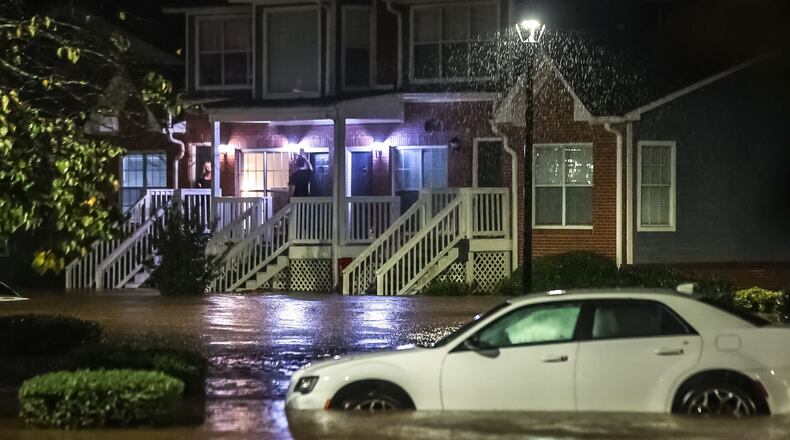As Helene churns through Georgia, the storm is leaving a path of heavy damage.
After the storm is over, many Georgians will face the big job of cleaning up and figuring out how to make repairs. Many homeowners, renters and vehicle owners will need to file insurance claims.
Helene made landfall Thursday night as a dangerous Category 4 storm in Florida’s Big Bend region and crossed over into South Georgia as a hurricane before being downgraded Friday morning to a tropical storm. But she can still pack a punch with heavy wind and rain across the state.
Insurance companies will send claims teams to the affected areas after the event so that customers can get the process of filing a claim started and get the money to repair their property in a timely manner. Some insurers even have mobile apps or online portals to get the process underway.
Here is a step-by-step guide on how to file an insurance claim following a hurricane or flood:
1. It is important to file the claim with your insurer as soon as possible. Thousands of people will be filing claims, and you want to get yours as high as you can on the list.
2. The Insurance Information Institute, an organization that provides guidance on insurance issues, suggests you make temporary repairs to your home if they are needed to protect it from further damage. Save the receipts for supplies so you can turn them in for reimbursement.
3. Once you are able to speak to an insurer, you will need to ask these questions:
- Is the damage you described covered under the terms of your policy?
- How long do you have to file a claim?
- How long will it take to process the claim?
- Do you need estimates for repairs?
4. This step is very important: Once you make the claim, be sure to write down the claim number. Again, insurers will be dealing with thousands of people — make it easy for them to communicate with you about your claim by having the claim number written down where you can find it.
5. When you speak to your insurer, record the day and time of the conversation and with whom you spoke. Take notes about what is said and if any monetary amounts are mentioned.
6. You need to be ready to provide an accurate description of damages to your insurer. If you can safely do it, walk around your home and make notes on what was damaged.
7. After you contact them, your insurance company will send you a “proof of loss” form to complete or will send an adjuster — a person trained to assess the damage to property — to your home to get the information on your losses. To speed this process along, start gathering information about your property and the items that were lost or destroyed. A proof of loss form will ask you to describe the items damaged or destroyed, provide the approximate date of purchase and estimate the cost to repair it or replace it. If you happen to be able to produce receipts for items, that would be a help as well.
Credit: John Spink
Credit: John Spink
8. Another step you can take to document what was damaged is to photograph or videotape the damage. Be sure to point out structural damage in the photos or video.
9. Do not throw out damaged items. You want an adjuster to see them first.
10. If you are unable to live in your home and must stay elsewhere, keep all receipts for any living expenses — hotel rooms, food, and other costs of evacuation. Most homeowner policies that cover windstorm damage will cover those costs.
11. Be wary of anyone who comes to your door offering to do repairs or claiming to be insurance adjusters.
12. If you have no insurance, you can register for federal disaster relief at DisasterAssistance.gov. You do that by downloading the FEMA mobile app or by calling 1-800-621-3362.
Disaster assistance can help with temporary housing, home repairs and other disaster-related expenses, including crisis counseling and legal assistance. Click here for more information on FEMA aid.
Water vs. wind: What is covered?
Hurricanes cause wind and water damage.
Homeowners insurance does not cover flood damage — including flooding that is caused by storm surge. You would have needed to have flood insurance to pay for damages caused by water beforehand. Structures or belongings that were damaged by flooding are covered only by flood insurance.
Wind damage is not covered in some coastal states. You would have had to purchase a separate windstorm policy in advance, which is a common thing in those coastal states. Both North Carolina and South Carolina are states where insurance companies can charge special deductibles for wind damage.
Damage to your car is generally covered by your automobile insurance.
For renters, rental insurance may cover damages from a hurricane, but there are limits. Damage from wind, lightning, and certain kinds of water damage might fall within the terms of coverage. Damage to a structure would be covered by the policy of the property owner. If you can’t live in your rental, your policy may cover the cost to stay elsewhere until your rental home is repaired.
Finally, be patient. It may take a while for someone to get to you and assess your damages.
—AJC staff writer J. Scott Trubey contributed to this report.
About the Author





